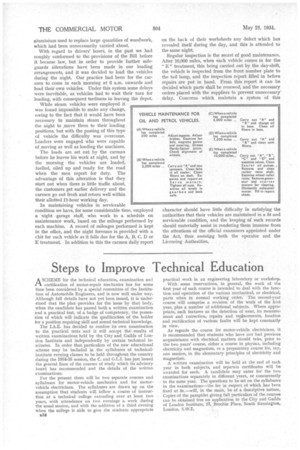Steps to Improve Technical Education
Page 52

If you've noticed an error in this article please click here to report it so we can fix it.
ASCHEME for the technical education, examination and certification of motor-repair mechanics has for some time been considered by a special committee of the Institution of Automobile Engineers, and is now well under way. Although full details have not yet been issued, it is understood that the plan provides for the issue by that body, when the candidate has passed both a written examination and a practical test, of a badge of competency, the possession of which will indicate the qualification of the holder for a position requiring skill and sound technical knowledge.
The I.A.E. has decided to confine its own examination to the practical tests and it will accept thn results of written examinations held by the City and Guilds of London Institute and independently by certain technical institutes. In order that particulars of the new educational scheme may be included in the syllabuses of technicalinstitute evening classes to be held throughout the country during the 1934-35 session, the C. and G.L.I. has just issued the general lines of the courses of study which its advisory hoard has recommended and the details of the written examinations.
For the present there will be two separate courses and syllabuses for motor-vehicle mechanics and for motorvehicle electricians. The syllabuses are drawn up on the assumption that students will follow a course of instruction at a technical college extending over at least two years, •with attendance on two evenings a week during the usual session, and with the addition of a third evening when the college is able to give the students appropriate E34 practical work in an engineering laboratory or workshop.
With some reservations, in general, the work of the first year of each course is intended to deal with the function and operation of the various mechanical, or electrical, parts when in normal working order. The second-year course will comprise a revision of the work of the first year, plus a number of additional subjects. Where appropriate, such features as the detection of wear, its measurement and correction, repairs and replacements, location and rectification of various faults will be kept constantly in view.
As regards the course for motor-vehicle electricians, it is recommended that students who have not had previous acquaintance with electrical matters should take, prior to the two years' course, either a course in physics, including electricity and magnetism, or a preparatory course for, say, one session, in the elementary principles of electricity and magnetism.
A written examination will be held at the end of each year in both subjects, and separate certificates will be awarded for each. A candidate may enter for the two examinations separately in different years, or concurrently in the same year. The questions to be set on the syllabuses in the examinations—the fee in respect of which has been fixed at 5s.—will, in the main, be of a descriptive nature. Copies of the pamphlet giving full particulars of the courses can be obtained free on application to the City and Guilds of London Institute, 37, Brechin Place, South Kensington, London, S.W.7.




































































































